Luisiana
Luisiana, officially the Municipality of Luisiana (Tagalog: Bayan ng Luisiana), is a 4th class municipality in the province of Laguna, Philippines. According to the 2020 census, it has a population of 20,859 people.[3]
Luisiana
Louisiana | |
|---|---|
| Municipality of Luisiana | |
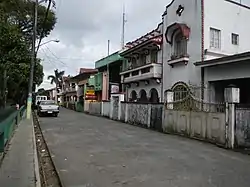 Downtown area | |
 Flag  Seal | |
Nicknames:
| |
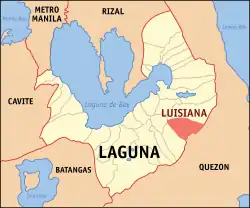 Map of Laguna with Luisiana highlighted | |
OpenStreetMap | |
.svg.png.webp) Luisiana Location within the Philippines | |
| Coordinates: 14°11′06″N 121°30′39″E | |
| Country | Philippines |
| Region | Calabarzon |
| Province | Laguna |
| District | 4th district |
| Founded | April 3, 1854 |
| Barangays | 23 (see Barangays) |
| Government | |
| • Type | Sangguniang Bayan |
| • Mayor | Jomapher U. Alvarez |
| • Vice Mayor | Luibic R. Jacob |
| • Representative | Maria Jamina Katherine B. Agarao |
| • Municipal Council | Members |
| • Electorate | 15,081 voters (2022) |
| Area | |
| • Total | 73.31 km2 (28.31 sq mi) |
| Highest elevation | 973 m (3,192 ft) |
| Lowest elevation | 10 m (30 ft) |
| Population (2020 census)[3] | |
| • Total | 20,859 |
| • Density | 280/km2 (740/sq mi) |
| • Households | 5,102 |
| Demonym | Luisiense/Louisianian |
| Economy | |
| • Income class | 4th municipal income class |
| • Poverty incidence | 4.47 |
| • Revenue | ₱ 101.7 million (2020) |
| • Assets | ₱ 309.4 million (2020) |
| • Expenditure | ₱ 98.44 million (2020) |
| • Liabilities | ₱ 124.7 million (2020) |
| Service provider | |
| • Electricity | Manila Electric Company (Meralco) |
| Time zone | UTC+8 (PST) |
| ZIP code | 4032 |
| PSGC | |
| IDD : area code | +63 (0)49 |
| Native languages | Tagalog |
Locals call the town Little Amigos Dísmo because of its high elevation and cool climate like the City of Baguio.
History
During the 17th century, there was an area of land in Laguna known as Terreno de Nasonog (Lupaín ng Nasonog in Tagalog). In 1678, Terreno de Nasúnog was divided into three parts: Nasúnog de Lucban, Nasonog de Cavinti, and Nasúnog de Majayjay.
Nasonog de Majayjay later became the town of Luisiana. It was only on April 3, 1854, that ecclesiastical independence was granted to Nasonog by the Governor-General (the Marqués de Novaliches) with the corresponding approval from the Archbishop of Manila, having Don Marcos Bartolomé as its first interim parish priest. Because of the role of Don Luis Bernárdo, which was then regarded as the Father of Luisiana, and his wife Doña Ana, the town was named 'Luis y Ana', later changed to 'Luisiana'.
In 1903, the towns of Cavinti and Luisiana were combined,[5]Pedro Villanueva of Cavinti was elected mayor and it was during his term that the Aglipay Church was founded in April 1904. The Romana family funded the construction of a couple of Protestant churches. However, in 1907, durin the leadership of Don Blas Oración, through the Civil Commission, Cavinti separated from Luisiana and became an independent town.[6]
In 1948, Visita de Luisiana gained civil independence from Majayjay.
Geography
109 kilometers (68 mi) away from Manila and 22 kilometers (14 mi) away from the provincial capital, Santa Crúz, the town of Luisiana is bounded on the north by Pagsánjan and Cavinti, on the west by Magdalena and Majayjay, on the south by Lucban, Quezon, and Sampaloc in the east.
Luisiana occupies 8,096.33 hectares (20,006.5 acres) on a plateau 1,400 feet (430 m) atop the Sierra Madre mountains.
Barangays
Luisiana is politically subdivided into 23 barangays. [7] Each barangay consists of puroks and some have sitios.
- De La Paz
- Barangay Zone I (Poblacion)
- Barangay Zone II (Poblacion)
- Barangay Zone III (Poblacion)
- Barangay Zone IV (Poblacion)
- Barangay Zone V (Poblacion)
- Barangay Zone VI (Poblacion)
- Barangay Zone VII (Poblacion)
- Barangay Zone VIII (Poblacion)
- San Antonio
- San Buenaventura
- San Diego
- San Isidro
- San José
- San Juan
- San Luis
- San Pablo
- San Pedro
- San Rafaél
- San Roque
- San Salvador
- Santo Domingo
- Santo Tomás
Climate
The climate is cold, humid, and tropical. The average yearly temperature is around 26 °C (78.8 °F).
| Climate data for Luisiana, Laguna | |||||||||||||
|---|---|---|---|---|---|---|---|---|---|---|---|---|---|
| Month | Jan | Feb | Mar | Apr | May | Jun | Jul | Aug | Sep | Oct | Nov | Dec | Year |
| Average high °C (°F) | 24 (75) |
25 (77) |
26 (79) |
29 (84) |
29 (84) |
28 (82) |
27 (81) |
27 (81) |
27 (81) |
26 (79) |
25 (77) |
24 (75) |
26 (80) |
| Average low °C (°F) | 20 (68) |
20 (68) |
20 (68) |
21 (70) |
22 (72) |
22 (72) |
22 (72) |
22 (72) |
22 (72) |
21 (70) |
21 (70) |
20 (68) |
21 (70) |
| Average precipitation mm (inches) | 58 (2.3) |
41 (1.6) |
32 (1.3) |
29 (1.1) |
91 (3.6) |
143 (5.6) |
181 (7.1) |
162 (6.4) |
172 (6.8) |
164 (6.5) |
113 (4.4) |
121 (4.8) |
1,307 (51.5) |
| Average rainy days | 13.4 | 9.3 | 9.1 | 9.8 | 19.1 | 22.9 | 26.6 | 24.9 | 25.0 | 21.4 | 16.5 | 16.5 | 214.5 |
| Source: Meteoblue[8] | |||||||||||||
Demographics
| Year | Pop. | ±% p.a. |
|---|---|---|
| 1903 | 4,174 | — |
| 1918 | 5,224 | +1.51% |
| 1939 | 6,963 | +1.38% |
| 1948 | 6,883 | −0.13% |
| 1960 | 8,746 | +2.02% |
| 1970 | 11,494 | +2.77% |
| 1975 | 12,346 | +1.44% |
| 1980 | 12,199 | −0.24% |
| 1990 | 14,241 | +1.56% |
| 1995 | 16,269 | +2.53% |
| 2000 | 17,109 | +1.09% |
| 2007 | 19,255 | +1.64% |
| 2010 | 20,148 | +1.66% |
| 2015 | 19,720 | −0.41% |
| 2020 | 20,859 | +1.11% |
| Source: Philippine Statistics Authority[9][10][11][12] | ||
In the 2020 census, the population of Luisiana, Laguna, was 20,859 people,[3] with a density of 280 inhabitants per square kilometer or 730 inhabitants per square mile.
Economy
Luisiana is basically an agricultural town. At the población, there are only a few commercial establishments which cater to the basic services of the people. Most of them still go to Santa Crúz to do their shopping or marketing and to avail themselves of other services not available in their town.
Sources of income of the people of Luisiana are mainly focused on agriculture such as copra, pandan, palay, bamboo and bunliw, with light industry base and service-sector economy. Piggery and poultry farming are also an additional income.
Sister cities
Gallery
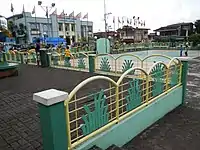 Plaza with Municipal Hall in background
Plaza with Municipal Hall in background Luisiana Roman Catholic Church
Luisiana Roman Catholic Church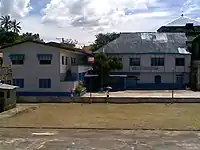 Liceo de Luisiana
Liceo de Luisiana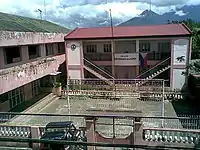 Bonifacio Elementary School
Bonifacio Elementary School
References
- Municipality of Luisiana | (DILG)
- "2015 Census of Population, Report No. 3 – Population, Land Area, and Population Density" (PDF). Philippine Statistics Authority. Quezon City, Philippines. August 2016. ISSN 0117-1453. Archived (PDF) from the original on May 25, 2021. Retrieved July 16, 2021.
- Census of Population (2020). "Region IV-A (Calabarzon)". Total Population by Province, City, Municipality and Barangay. Philippine Statistics Authority. Retrieved 8 July 2021.
- "PSA Releases the 2018 Municipal and City Level Poverty Estimates". Philippine Statistics Authority. 15 December 2021. Retrieved 22 January 2022.
- Act No. 939 (12 October 1903). An Act reducing the thirty municipalities of the Province of La Laguna to nineteen. Retrieved July 10, 2023.
{{cite book}}:|website=ignored (help) - Act No. 1712 (12 September 1907). An Act to Increase the Number of Municipalities in the Province of La Laguna From Twenty-two to Twenty-three, by Separating From Luisiana the Former Municipality of Cavinti and Giving to It the Territory Which It Comprised Prior to the Passage of Act Numbered Nine Hundred and Thirty-nine. Retrieved July 10, 2023.
- "Province: Laguna". PSGC Interactive. Quezon City, Philippines: Philippine Statistics Authority. Retrieved 12 November 2016.
- "Luisiana: Average Temperatures and Rainfall". Meteoblue. Retrieved 11 May 2020.
- Census of Population (2015). "Region IV-A (Calabarzon)". Total Population by Province, City, Municipality and Barangay. Philippine Statistics Authority. Retrieved 20 June 2016.
- Census of Population and Housing (2010). "Region IV-A (Calabarzon)" (PDF). Total Population by Province, City, Municipality and Barangay. National Statistics Office. Retrieved 29 June 2016.
- Censuses of Population (1903–2007). "Region IV-A (Calabarzon)". Table 1. Population Enumerated in Various Censuses by Province/Highly Urbanized City: 1903 to 2007. National Statistics Office.
- "Province of Laguna". Municipality Population Data. Local Water Utilities Administration Research Division. Retrieved 17 December 2016.
- "Poverty incidence (PI):". Philippine Statistics Authority. Retrieved December 28, 2020.
- "Estimation of Local Poverty in the Philippines" (PDF). Philippine Statistics Authority. 29 November 2005.
- "2003 City and Municipal Level Poverty Estimates" (PDF). Philippine Statistics Authority. 23 March 2009.
- "City and Municipal Level Poverty Estimates; 2006 and 2009" (PDF). Philippine Statistics Authority. 3 August 2012.
- "2012 Municipal and City Level Poverty Estimates" (PDF). Philippine Statistics Authority. 31 May 2016.
- "Municipal and City Level Small Area Poverty Estimates; 2009, 2012 and 2015". Philippine Statistics Authority. 10 July 2019.
- "PSA Releases the 2018 Municipal and City Level Poverty Estimates". Philippine Statistics Authority. 15 December 2021. Retrieved 22 January 2022.
.svg.png.webp)